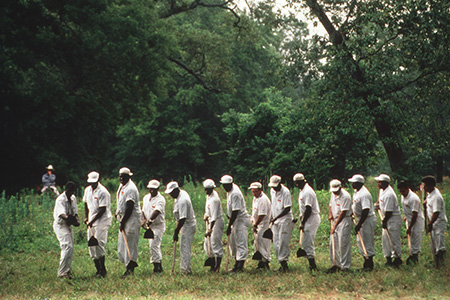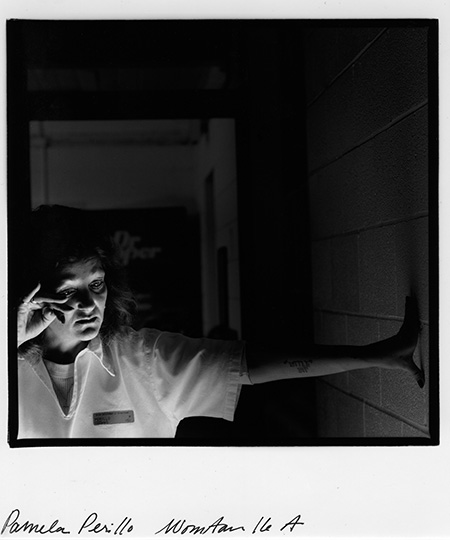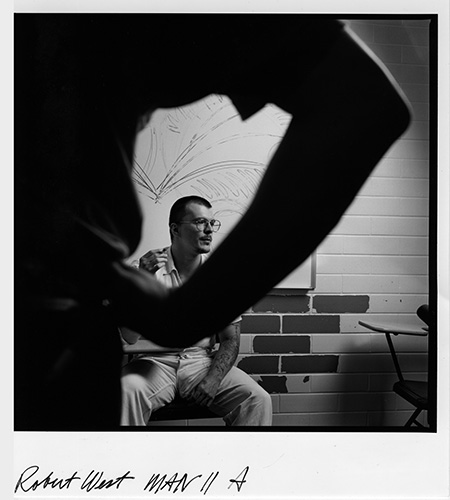Portraits from Death Row exhibit opens April 3

On Friday, April 3, Final Exposure: Portraits from Death Row, an exhibition of photography by African American commercial and documentary photographer Lou Jones, opens at the Huret & Spector Gallery at Emerson College.
The exhibit is open to the Emerson community. The Huret & Spector Gallery is located on the sixth floor of the Tufte Performance and Production Center, 10 Boylston Place, Boston, MA. Visiting hours: Monday–Friday, 2:00–6:00 pm, or by appointment.
The exhibit, which includes 27 black and white portraits of inmates from death rows in prisons across the country, is curated by Mirta Tocci, assistant professor in the Institute for Liberal Arts and Interdisciplinary Studies at Emerson College, with support from the Institute for Liberal Arts and Interdisciplinary Studies, the Department of Visual and Media Arts, and the Office of Diversity and Inclusion.
In Final Exposure: Portraits from Death Row, Jones’s powerful images humanize the condemned men and women on death row without minimizing the magnitude of their crimes or the pain of the victims and their families. The portraits are accompanied by Jones’s eloquent personal commentary, published in his book by the same name (Northwestern University Press: 1996). Together they open one’s eyes to the chilling reality of death row and challenge spectators to question the morality of capital punishment.

In a statement about the exhibit, Jones says: “The Final Exposure project actually started for me at about age 15 when I argued the issues of the death penalty with my father. Throughout the Civil Rights movement, the Vietnam War, in college and afterward, it stayed with me. Six years of my life have been devoted to documenting the unseen, unheard stories of an American subculture—people on death row. I wanted to see if art could make a difference.”
This is Lou Jones’s first exhibit in the Huret & Spector Gallery. “Lou looked into the eyes of the condemned. He photographed and interviewed these men and women. His experience working on this multi-year project gave him insight into the causes of violence and a point of view toward state-sponsored violence in the form of capital punishment,” said Tocci, who has curated Jones’s work previously.
Tocci timed the exhibit to coincide with the Adventures in Ethics Series Lecture “Life on Death Row: A Critical Phenomenology of State Execution” presented by Lisa Guenther, associate professor of philosophy at Vanderbilt University, on April 14, 4:00–6:00 pm, in the Charles Beard Room, second floor of the Little Building, 80 Boylston Street, Boston, MA.

About the Artist
Lou Jones’s eclectic career has evolved from commercial to the personal. It has spanned every format, film type, artistic movement, and technological change. He has photographed for Fortune 500 corporations including Federal Express, Aetna, Adidas, and Nike; completed assignments for magazines and publishers all over the world, such as Time/Life, National Geographic, and Paris Match; initiated long-term projects on the civil wars in Central America, Olympic Games, Japan, and pregnancy; and published many books. His work is included in collections at the Smithsonian Institution, DeCordova Museum, Fogg Museum, Wellesley College, and the University of Texas. Jones has served on the boards of directors of numerous photographic associations, societies, and museums, such as the American Society of Media Photographers, Photographic Resource Center, and the Griffin Museum of Photography. Nikon has honored him as a “Legend Behind the Lens” and Lowepro named him one of its “Champions.” Recently he has embarked on his most ambitious long-term works: the Downtown Crossing Project and panAfricaproject.org.
About the Huret & Spector Gallery
The Huret & Spector Gallery is a vital educational and cultural component of Emerson College, serving the needs of the Emerson academic community and the Boston community at large. The gallery invigorates the academic curriculum and attracts visitors from the community through exhibitions of new work produced by contemporary artists, faculty, and students. Corresponding educational programs explore global perspectives on art and art discourse. For more information, visit emerson.edu.
The Harry L. Huret & Ellen Marr Spector Gallery was funded by a gift from Judith Spector Huret in 1999. Judith Huret received an MA in Communication Sciences and Disorders from Emerson in 1969 and has been a member of the Emerson College Board of Trustees since 2001.
Categories